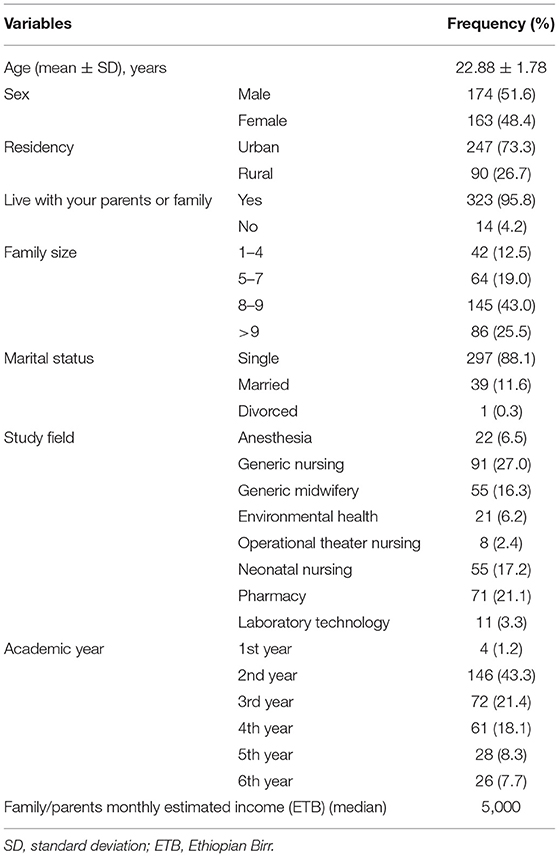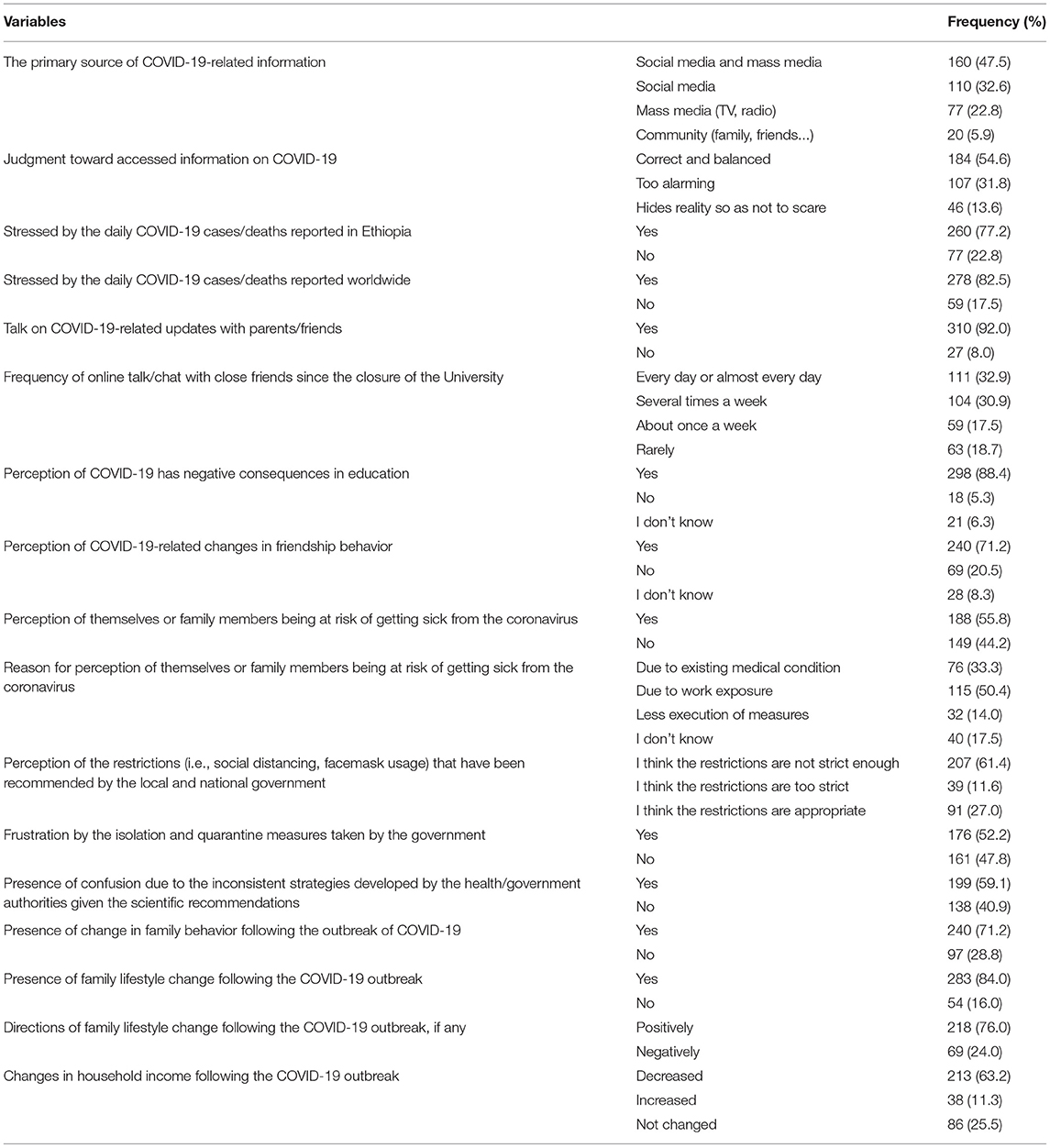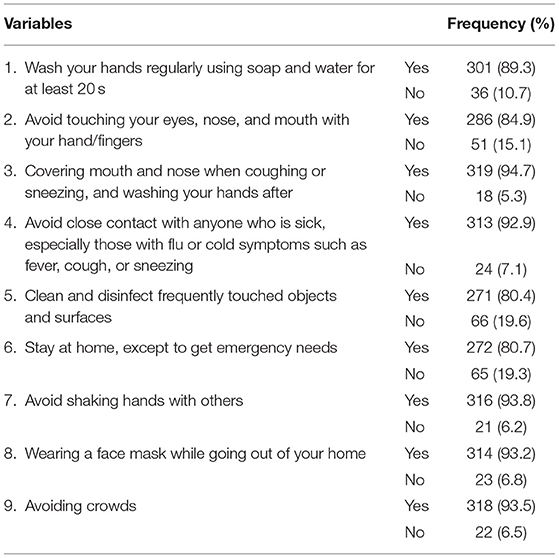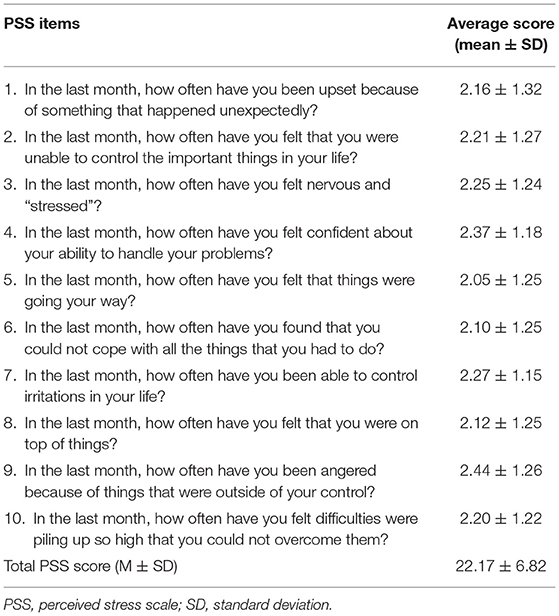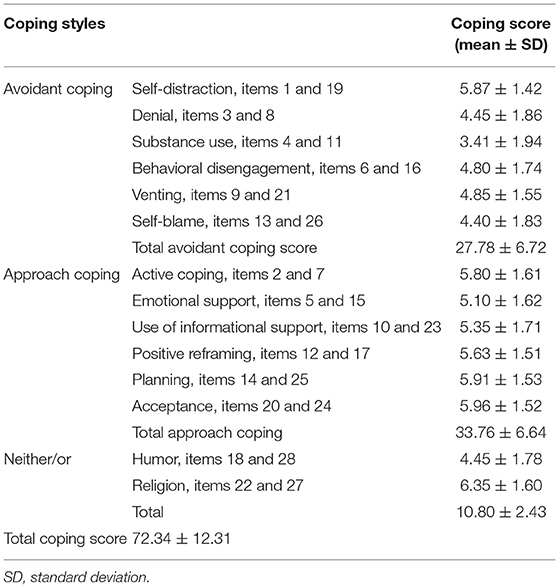- 1Department of Clinical Pharmacy, Faculty of Health Science, School of Pharmacy, Institute of Health, Jimma University, Jimma, Ethiopia
- 2Faculty of Health Science, School of Nursing, Institute of Health, Jimma University, Jimma, Ethiopia
Background: The rapid spread of COVID-19 infection has led countries across the globe to take various measures to contain the outbreak, including the closure of Universities. Forcing University students to stay at home has created enormous stress and uncertainty in their daily life.
Objective: This study aimed to assess the perceived stress and coping strategies among undergraduate health science students of Jimma University amid the COVID-19 outbreak.
Materials and methods: An online cross-sectional survey was conducted involving 337 undergraduate health science students from August to September 5, 2020. The perceived stress scale (PSS)-10 and Brief-COPE scale were used to assess the level of stress and coping strategies, respectively. Statistical Package for Social Science (SPSS) Version 22 was employed for data analysis. Logistic regression was conducted to identify predictors of high perceived stress.
Results: The overall mean [±standard deviation (SD)] age of the participants was 22.88 (±1.78) years. The mean (±SD) PSS score was 22.16 (±1.41), and high perceived stress was reported in 121 (35.9%) participants. The overall mean (±SD) coping score was 72.34 (±12.31), and approach coping was the predominantly used strategy for coping with stress. Personal perception of being stressed by the daily number of COVID-19 cases/deaths in Ethiopia (AOR = 4.61, p < 0.01), rare online talk/chat with friends (AOR = 4.07, p = 0.01), presence of confusion due to the inconsistent strategies developed by the health/government authorities in view of the scientific recommendations (AOR = 2.22, p = 0.01), perception of self/family members being at risk of getting sick (AOR = 0.53, p = 0.03), decreased household income following the COVID-19 pandemic (AOR = 3.92, p = 0.01), practicing denial (AOR = 1.34, p < 0.01), self-blame (AOR = 1.23, p = 0.02), planning (AOR = 1.28, p = 0.01), and religion (AOR = 1.41, p < 0.01) as means of coping with stress were associated with high perceived stress.
Conclusion: Over one-third of the participants had a high level of perceived stress, and the majority of them were practicing effective means of coping with stress. The authors recommend that the hosting University in collaboration with the concerned bodies develop innovative strategies to improve the psychological well-being of the students.
Introduction
As of the second half of January 2021, over 98 million COVID-19 infections were recorded globally claiming the lives of over 2.1 million people (Medicine, 2020). In response to the expeditious increase in the number of COVID-19 infections and the World Health Organization‘s declaration of the infection as a pandemic (WHO, 2020b), governments across the world implemented early wide-ranging control measures to mitigate its spread and impact. The measures taken included travel/transportation bans from specific locations, closures of selected institutions and borders, quarantine, self-isolation, and social distancing measures (ACAPS, 2020).
Though the measures adopted to contain the COVID-19 infection were justifiable, the measures greatly impacted the psychosocial, economic, and political aspects of the population across the globe (Bank, 2020; WHO, 2020a). The fear of exposure to infection, subsequent risk of infecting family members and loved ones, prolonged quarantine, fear of relative's death, and concerns about educational progression and other fears have grown tremendously. Thus, COVID-19 has the potential to leave a devastating mark on the psyche of the people, including students across the world (Mohammed et al., 2020; WHO, 2020a).
With the spread of the COVID-19 infection, more than 1.5 billion students and young people across the planet were forced to stay at home due to the closure of schools and Universities, leading to enormous anxiety and uncertainty (Husain, 2020; UNESCO, 2020). Social distancing measures and cessation of face-to-face teaching at higher educational institutes put students in an altogether new position without a well-defined estimate of how long it will last, compromising their daily life (IESALC, 2020). University and college students are especially prone to feelings of loneliness, and they experience higher rates of anxiety and depression compared to the general population (Rahman et al., 2012; Diehl et al., 2018). During the era of COVID-19, due to social isolation, uncertainty, and abrupt transitions, students are prone to further worsening of these feelings (Psychiatry, 2020).
Looking at the experiences of the world, the Ethiopian government took multiple measures, such as closure of schools and restricting large gatherings and movements of people. Additionally, the government adopted WHO's basic measures to reduce transmission of COVID-19 including washing hands frequently using soap, maintaining social distancing, staying informed and following advice given by your healthcare provider, and staying at home if you begin to feel sick. These measures were communicated to the general public through various media platforms (Baye, 2020; Hailu, 2020).
Numerous worldwide studies were conducted to assess the level of perceived stress among University students before the COVID-19 pandemic (Shah et al., 2010; Borjalilu et al., 2015; Ahmed and Prashantha, 2018; Gazzaz et al., 2018; Al-Qahtani and Alsubaie, 2020; Karyotaki et al., 2020; Tariq et al., 2020), but only limited studies were conducted on the same issue during the COVID-19 outbreak. The available studies reported a high perceived stress level for students ranging from 12.6 to 30.2% during the current pandemic (AlAteeq et al., 2020; Pedrozo-Pupo et al., 2020; Sheroun et al., 2020). A study from China revealed that ~25% of the study population experiencing anxiety symptoms, which were positively correlated with increased concerns about academic delays, economic effects of the pandemic, and impacts on daily life (Cao et al., 2020). In Ethiopia, it is estimated that the prevalence of anxiety and depression symptoms has tripled from pre-outbreak estimates (Monitor, 2020). A previous study in Ethiopia revealed that high perceived stress was apparent in more than half of healthcare providers (51.6%) (Chekole et al., 2020), and another study involving University students reported stress in 32.5% of the participants (Aylie et al., 2020).
Medical students experience more stress compared to students of other subjects (Kebede et al., 2019; Olum et al., 2020; Worku et al., 2020). In Ethiopia, age, class, study year, practical attachment, poor/low social support, having stressful life events, financial problems, and thinking about future career expectations were identified as factors related to perceived stress among health science students (Kebede et al., 2019; Worku et al., 2020). On top of pre-existing factors, the unprecedented disruptions in health education and other activities due to the COVID-19 outbreak (Alsoufi et al., 2020) is expected to further affect the mental health of these students. Thus, students had to cope with their own fears, stresses, and insecurity. The way of coping with a stressful event, like the COVID-19 crisis, affects physical health, medical conditions, and emotional well-being either positively or negatively (CDC, 2020). Despite the recent reopening of face-to-face University education, no research has assessed the perceived stress levels and coping strategies of University students during the COVID-19 pandemic in Ethiopia. Therefore, the current study aimed to explore the perceived stress level, associated factors, and stress coping strategies used among health science students of Jimma University amid the COVID 19 outbreak. The hypothesis of this research is that COVID-19-related events increase the risk of high perceived stress level and change stress coping strategies.
Materials and Methods
Study Design and Setting
A cross-sectional online surveillance study was conducted at Jimma University from August to September 5, 2020. Jimma University is one of the well-known Universities in Ethiopia, located in the southwest part of the country. It has six colleges and four institutes, one of which is the Institute of Health Sciences (University, 2020), which includes the department of Anesthesia, School of Nursing and Midwifery (Generic Nursing, Generic Midwifery, Operational Theater Nursing, Neonatal Nursing), School of Environmental Health, School of Pharmacy, and School of Laboratory Technology.
Participants
Eligibility Criteria
All undergraduate health science students of Jimma University who were willing and able to respond to online questionnaires were included in the study. A total of 337 health science students participated in the study.
Variables
Independent Variables
Sociodemographic variables (age, sex, residence, living with your parents or family, family size, marital status, field of study, academic year, and household average monthly income), COVID-19-related experience variables, and variables related to measures taken for the prevention of COVID-19.
Dependent Variables
Perceived stress level and coping approaches to stress.
Sample Size and Sampling Technique
The sample size was calculated using Open-Epi version 2 with consideration of a 5% margin of error, 95% confidence interval, a 50% prevalence of perceived stress associated with the COVID-19 outbreak, and a 1,528 population size. Adding a non-response rate of 10%, the final sample size was 337 students. The participants were recruited by a non-probability sampling technique (a combination of purposive and snowball sampling techniques).
Data Collection Instrument and Process
The surveillance questionnaire was developed on Google Forms following the review of different kinds of literature. The questionnaire has five sections; sociodemographic characteristics, COVID-19-related experience, WHO precautionary measures, perceived stress scale (PSS-10), and Brief-COPE scale (see Supplementary Data for the collection format).
The perceived stress scale (PSS)-10 (Program, 2020) is the most widely used and validated psychological instrument for measuring the perception of stress and it has also been validated in Ethiopian University students (Manzar et al., 2019). The PSS-10 includes direct queries about current levels of experienced stress. The questions in the PSS ask about the feelings and thoughts of the last month. In each case, respondents are asked how often they felt a certain way. For instance, “In the last month, how often have you been upset because of something that happened unexpectedly?,” “In the last month, how often have you felt that you were unable to control the important things in your life?,” etc.
Each item provides five response options: (i.e., 0 = never, 1 = almost never, 2 = sometimes, 3 = fairly often, 4 = very often). PSS scores were obtained by reversing responses (0 = 4, 1 = 3, 2 = 2, 3 = 1, & 4 = 0) to the four positively stated items (4, 5, 7, and 8). Total scores were obtained by summing all the scale items with a total score range between 0 and 40. In this study, PSS-10 scores equal to or higher than 25 were deemed as high perceived stress, while scores <25 were considered as low perceived stress associated with COVID-19 (Pedrozo-Pupo et al., 2020).
Brief-COPE Strategy Scale
The Brief-COPE (NovoPsych, 2020) scale is a 28-item self-report questionnaire designed to measure effective and ineffective ways to cope with a stressful life event. To list some, “I've been turning to work or other activities to take my mind off things,” “I've been concentrating my efforts on doing something about the situation I'm in,” etc. Each question has a 4-point Likert item from “I haven't been doing this at all” to “I've been doing this a lot” (1 = I haven't been doing this at all, 2 = I've been doing this a little bit, 3 = I've been doing this a medium amount, 4 = I've been doing this a lot). The tool has been used in a previous study in Ethiopia (Telake Azale et al., 2018). The term “coping” is defined broadly as an effort used to minimize distress associated with negative life experiences. The coping approaches are broadly categorized as avoidant coping, approach coping, and neither/or, with each category containing subscales.
1. Avoidant coping: characterized by the subscales of denial, substance use, venting, behavioral disengagement, self-distraction, and self-blame. Avoidant coping is associated with poorer physical health among those with medical conditions.
2. Approach coping: characterized by the subscales of active coping, positive reframing, planning, acceptance, seeking emotional support, and seeking informational support. Approach coping is associated with more helpful responses to adversity, including adaptive practical adjustment, better physical health outcomes, and more stable emotional responses.
3. Neither/or: characterized by the subscales of humor and religious ways of coping with stress.
First, each class's representative phone number was accessed from respective departments and we called to them to justify the purpose of the study. Following this, the survey link was then forwarded by Telegram to the representative of each class using their phone numbers. Thereafter, the representative of each class shared the link with the common Telegram address of their class, using a purposive sampling technique. Finally, students who saw the link in the common Telegram address shared the link further to their classmates via Facebook and WhatsApp, using the snowball sampling technique.
In our study, using the Cronbach alpha, the Brief-COPE-28 item (Cronbach alpha equal to 0.844) and the PSS-10 item (Cronbach alpha equal to 0.741) had high and good internal consistencies, respectively. The avoidant coping, approach coping, and neither/or broad categories of coping approaches had good (Cronbach alpha equal to 0.777), high (Cronbach alpha equal to 0.812), and poor (Cronbach alpha equal to 0.455) internal consistencies, respectively.
Data Quality Assurance
The questionnaires were translated from English to two dominant local languages (Amharic and Afan Oromo) and back-translated into English by an independent person to assure its consistency. The tool was pre-tested on private college health science students, before starting the actual data collection and then any necessary adjustment was done. The data were compiled, coded, and checked for consistency before analysis.
Data Analysis
The CSV formatted data from Google Forms were exported to SPSS version 22.0 for analysis. A continuous data normality test was conducted using Shapiro-Wilk's W-test. For this purpose, a level of significance of 0.05 was used. Parametric data were reported with mean and standard deviation, whereas non-parametric data were reported with the median. Frequency and percentage were computed for categorical variables and a chi-square test was conducted to check for cell adequacy. Bivariate logistic regression was carried out to investigate the associations between the perceived stress level and independent variables/coping strategies. Then, a backward, stepwise multivariate logistic regression [reported with adjusted odds ratios (AOR) with 95% confidence intervals (95% CI)] was performed including all explanatory variables with a p < 0.25 on bivariate logistic regression to evaluate factors independently associated with high perceived stress level. All p-values calculated were two-sided, and the statistical significance threshold was <0.05.
Results
Baseline Characteristics
A total of 337 health science students were involved in the study. The overall mean (±SD) age of the participants was 22.88 (±1.78) years, and the participants were comparable in terms of sex (male = 51.6% vs. female = 48.4%). Nearly three-quarters (73.3%) of the participants reported urban residence (Table 1).
COVID-19 Related Experiences
A total of 160 (47.5%) students reported predominant use of social media and mass media as the primary source of COVID-19-related information. Most of the students, 298 (88.4%), believe that COVID-19 will have negative consequences on their education. Furthermore, the majority of the participants, 188 (55.8%), think that their family members are at risk of contracting COVID-19, mainly due to work exposure. Above half of the students, 176 (52.2%), reported frustration from the isolation and quarantine measures imposed by the government. Confusion from the inconsistency of health/government authorities' strategies with the scientific recommendations was reported by 199 (59.1%). Regarding income after the COVID-19 outbreak, 213 (63.2%) participants reported a decrease in household income (Table 2).
Measures Taken for the Prevention of COVID-19
In this study, a significantly higher proportion of the participants reported practicing all aspects of the COVID-19 infection prevention modalities as per the WHO recommendations (Table 3).
Perceived Stress Scale
The overall mean (±SD) PSS score was 22.16 (±1.41). The item, “in the last month, how often have you been angered because of things that were outside of your control?,” achieved the highest PPS score with a mean (±SD) value of 2.44 (±1.26), and the item with the lowest PSS score was, “in the last month, how often have you felt that things were going your way?,” with a mean (±SD) PSS score of 2.05 (±1.25) (Table 4). In this study, high perceived stress levels were reported by 121 (35.5%) of the participants, while low perceived stress was reported by 216 (64.5%) of them.
Coping Strategies
The students have reported various means of coping with COVID-19-related stress experiences. Based on the Brief-COPE strategy, the mean (±SD) of the total coping score was 72.34 (±12.31). Of the broad categories of coping approaches, approach coping achieved the highest mean (±SD) score, 33.76 (±6.64). Among subscales of coping strategies, religion achieved the highest mean (±SD) score accounting for 6.35 (±1.60), while substance use was the least stress coping strategy reported with a score of 3.41 (±1.91) (Table 5).
Factors Associated With the Perceived Stress Level
In bivariate logistic regression, 29 variables achieved a p < 0.25 and were recruited for multivariate analysis. Of the 29 candidate variables, family size of 8–9 (p = 0.02), personal perception of being stressed by the daily number of COVID-19 cases/deaths in Ethiopia (p < 0.001), perception of COVID-19-related changes in friendship behavior (p = 0.02), perception of family members at risk of getting sick from the coronavirus (p < 0.001), frustration due to the isolation and quarantine measures taken by the government (p = 0.01), presence of confusion due to the inconsistent strategies developed by health/government authorities in view of scientific recommendations (p < 0.001), presence of a change in family behavior following the outbreak of COVID-19 (p < 0.001), presence of family lifestyle change following the COVID-19 outbreak (p =0.025), inconsistency of the household income following the COVID-19 outbreak (decreased, p = 0.002 and increased, p = 0.004), self-distraction, items 1 and 19 (p = 0.19), denial, items 3 and 8 (p < 0.01), substance use, items 4 and 11 (p = 0.01), behavioral disengagement, items 6 and 16 (p < 0.01), venting, items 9 and 21 (p < 0.01), self-blame, items 13 and 26 (p < 0.01), active coping, items 2 and 7 (p = 0.03), emotional support, items 5 and 15 (p = 0.04), use of informational support, items 10 and 23 (p < 0.01), positive reframing, items 12 and 17 (p < 0.01), planning, items 14 and 25 (p < 0.01), and religion, items 22 and 27 (p < 0.01) were significantly associated with perceived stress level on the bivariate logistic regression analysis.
On multivariate logistic regression analysis, personal perception of being stressed by the daily number of COVID-19 cases/deaths in Ethiopia [AOR = 4.61, 95% CI (1.57–13.50), P < 0.01], rare online talk/chat with friends [AOR = 4.07, 95% CI (1.77–9.35), p = 0.01], presence of confusion due to the inconsistent strategies developed by health/government authorities in view of the scientific recommendations [AOR = 2.22, 95% CI (1.19–4.14), p = 0.01], perception of self/family members being at risk of getting sick [AOR = 0.53, 95%CI (0.29–0.95), p = 0.03], and decreased household income following the COVID-19 pandemic [AOR = 3.92, 95% CI (1.36–11.33), p = 0.01] were independently associated with perceived stress level. Among subscales of coping strategy, denial, items 3 and 8 [AOR = 1.34, 95% CI (1.11–1.62), p < 0.01], self-blame, items 13 and 26 [AOR = 1.23, 95% CI (1.02–1.49), p = 0.02], planning, items 14 and 25 [AOR = 1.28, 95% CI (1.04–1.58), p = 0.01], and religion, items 22 and 27 [AOR = 1.41, 95% CI (1.14–1.75), p < 0.01] means of coping were associated with perceived stress (Table 6).
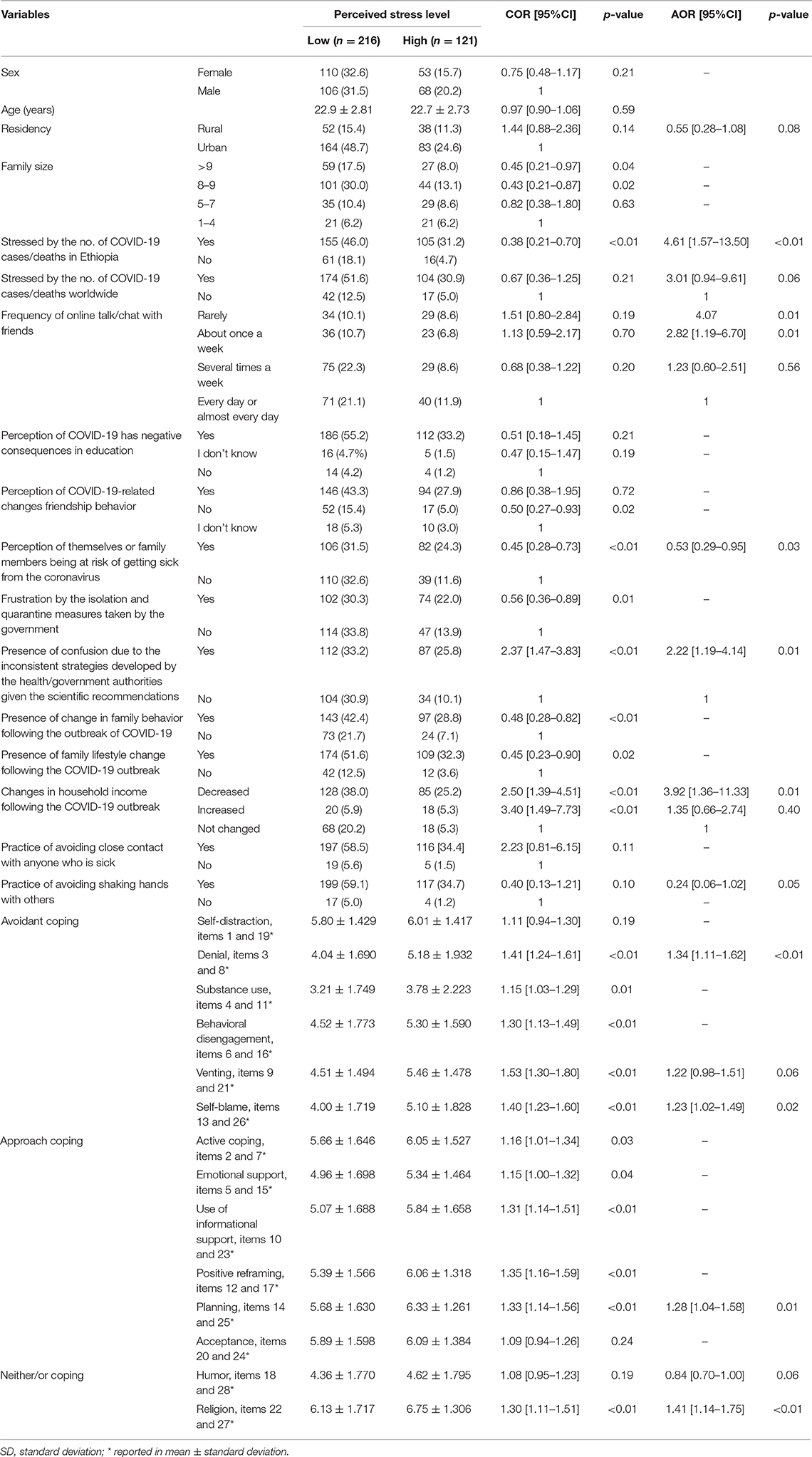
Table 6. Bivariate and multivariate analysis to identify factors associated with perceived stress level.
Discussion
This cross-sectional surveillance study was undertaken involving 337 undergraduate health science students to assess the perceived stress level and coping strategies amid the COVID-19 pandemic. More than one-third (35.9%) of participants experienced high perceived stress. The overall mean PSS score was 22.17 (±6.82), whereas the total mean of the stress coping score was 72.34 (±12.31).
The prevalence of high perceived stress was relatively higher in the current study than in other previous studies. In Colombia, Pedrozo-Pupo et al. (2020) found that 14.3% of the participants reported high perceived distress during the COVID-19 pandemic. In another study, Sheroun et al. (2020) reported that 13.3% of Bachelor science of nursing students suffered from high perceived stress. This difference might be explained by the difference in the study population; unlike the current study, the Pedrozo et al. study recruited professors, students, and health professionals, while, Sheroun et al. enrolled only Bachelor science nursing students. Which might reflect the significant difference in perceived stress level across different populations and, additionally, it may show cross-country discrepancies of the PSS amid the COVID-19 pandemic.
During a crisis, such as the outbreak of COVID-19, effective coping strategies play a vital role in managing distress and developing resilience. The type of stress coping employed in such circumstances is believed to impact health differently resulting in either poor or better health outcomes (NovoPsych, 2020; Polizzi et al., 2020). In our study, among subscales of coping, religion as a means of coping with stress achieved the highest mean score followed by planning and acceptance. On the contrary, substance use was the lowest means reported for coping with stress. Similarly, a study on medical students from Qatar reported religion, planning, and acceptance as the three most frequent means of coping with stress. Moreover, the Qatar study corroborates our finding of substance use as the lowest used means of coping with stress (Slah Eddine and Adawi, 2020). Overall, of a broad categories of coping, our study participants reported approach coping as a major means of coping with stress. This implies that the majority of the students were practicing effective means of coping with stress, which is associated with better physical health outcomes (NovoPsych, 2020).
Students who perceived being stressed by the daily number of COVID-19 cases/deaths in Ethiopia were four times more likely to have a high perceived stress level. This might be explained by an increment in alarming information that led to a drastic increase in stress-related conditions and mental health issues (Fernandes, 2020; Vinkers et al., 2020). Consistent with a study report from Colombia (Pedrozo-Pupo et al., 2020), our study also identified an association between confusion due to the inconsistent strategies developed by the health/government authorities in view of scientific recommendations and high perceived stress level. Inconsistent recommendations and messaging by health/government authorities leads to confusion or omitting steps or making other errors which can result in an increased risk of contamination and infection, which ultimately distress the individual (Peters et al., 2020). There is evidence that social media exposure is associated with psychological distress among college students (Hong et al., 2020) and similarly, poor social interaction (less sharing of ideas with friends, families, and community) influenced students' perceptions of stress (Stoliker and Lafreniere, 2015). In the current study, students who rarely talk/chat with their friends online were at a more than four-fold higher risk of having high perceived stress compared with those who talk/chat every day in the current pandemic. In the present study, decreased household income following the COVID-19 outbreak increased the risk of high perceived stress. This finding is consistent with a study report from Italy (Flesia et al., 2020). The emergency of the COVID-19 pandemic has caused a multitude of crises, one of which is economic (Bank, 2020). Decreased household income results in the inability to execute daily demands; this challenge will increase personal stress level.
Among subscales of coping strategies reported by the students, denial, self-blame, planning, and religion significantly increased the risk for high perceived stress. Denial and self-blame are part of the avoidance coping strategies of trying to avoid stressors instead of dealing with them. They are maladaptive (or unhealthy) ways of coping with stress because they often exacerbate stress without helping a person deal with the things that are causing them stress (Dijkstra and Homan, 2016). The increased risk of high perceived stress by using religion and planning as stress coping strategies could be an unfortunate finding or could be related to the unprecedented impact of COVID-19 on activities like religious practices and planning.
The present study has some limitations. Selection bias due to the sampling techniques employed dictates the cautious interpretation of the findings. Additionally, the authors adopted an existing scale to measure perceived stress and coping strategies associated with COVID-19. Furthermore, the study only enrolled health science students from a single institution, which might limit inference to health science students throughout Ethiopia as well as students of other subjects in the same institution.
Conclusion
More than one-third of the participants had a high level of perceived stress, and the majority of them were practicing effective means of coping with stress. Personal perception of being stressed by the daily number of COVID-19 cases/deaths in Ethiopia, rare online talk/chat with friends, presence of confusion due to the inconsistent strategies developed by the health/government authorities in view of scientific recommendations, and decreased household income following the COVID-19 pandemic were the predicting factors of high perceived stress level. Among the subscales of coping strategies, denial, self-blame, planning, and religious means of coping with stress were associated with high perceived stress. The authors recommend that the hosting University in collaboration with the concerned bodies develop innovative strategies to improve the psychological well-being of the students in parallel with class courses using online platforms as well as expanding the existing student counseling facilities. The health/government authorities have to develop consistent strategies in view of the scientific recommendations to contain the pandemic. Besides, longitudinal studies have to be conducted to assess the long-term psychological/psychiatric impact of the COVID-19 pandemic as well as the cognitive and academic performance impact of it. Moreover, research with large sample sizes and identifying the sources of stress among the students are warranted.
Data Availability Statement
The original data presented in the study are included in the article/Supplementary Material, further inquiries can be directed to the corresponding author/s.
Ethics Statement
The studies involving human participants were reviewed and approved by Institutional review board (IRB) of Jimma University, Ethiopia. The patients/participants provided their written informed consent to participate in this study.
Author Contributions
MA, BT, SA, and GM conceptualized and designed the study. MA and BT analyzed the data, interpreted the findings, and wrote the manuscript. All authors read and approved the final manuscript.
Conflict of Interest
The authors declare that the research was conducted in the absence of any commercial or financial relationships that could be construed as a potential conflict of interest.
Acknowledgments
We would like to acknowledge the participants of this study for their willingness to participate in the survey.
Supplementary Material
The Supplementary Material for this article can be found online at: https://www.frontiersin.org/articles/10.3389/fpsyg.2021.639955/full#supplementary-material
Abbreviations
AOR, adjusted odds ratios; COVID-19, coronavirus infection disease-2019; ETB, Ethiopian Birr; M, mean; PSS, perceived stress scale; SD, standard deviation; SPSS, Statistical Package for Social Science.
References
ACAPS (2020). COVID-19 Governments' Measures: Report #1–19 March 2020. Retrieved from https://reliefweb.int/report/world/covid-19-governments-measures-report-1-19-march-2020 (accessed October 12, 2020).
Ahmed, M., and Prashantha, B. (2018). Perceived stress and source of stress among undergraduate medical students of government medical college, Mysore. Int. J. Community Med. Public 5, 3513–3518. doi: 10.18203/2394-6040.ijcmph20183090
AlAteeq, D. A., Aljhani, S., and AlEesa, D. (2020). Perceived stress among students in virtual classrooms during the COVID-19 outbreak in KSA. J. Taibah Univ. Med. Sci. 15, 398–403. doi: 10.1016/j.jtumed.2020.07.004
Al-Qahtani, M. F., and Alsubaie, A. S. R. (2020). Investigating stress and sources of stress among female health profession students in a Saudi University. J. Multidiscip. Healthc. 13, 477–484. doi: 10.2147/JMDH.S255781
Alsoufi, A., Alsuyihili, A., Msherghi, A., Elhadi, A., Atiyah, H., Ashini, A., et al. (2020). Impact of the COVID-19 pandemic on medical education: Medical students' knowledge, attitudes, and practices regarding electronic learning. PLoS ONE 15:e0242905. doi: 10.1371/journal.pone.0242905
Aylie, N. S., Mekonen, M. A., and Mekuria, R. M. (2020). The psychological impacts of COVID-19 pandemic among University students in bench-sheko zone, south-west Ethiopia: a community-based cross-sectional study. Psychol. Res. Behav. Manag. 13, 813–821. doi: 10.2147/PRBM.S275593
Bank, W. (2020). The Global Economic Outlook During the COVID-19 Pandemic: A Changed World. Retrieved from https://www.worldbank.org/en/news/feature/2020/06/08/the-global-economic-outlook-during-the-covid-19-pandemic-a-changed-world (accessed January 23, 2021).
Baye, K. (2020). COVID-19 Prevention Measures in Ethiopia: Current Realities and Prospects, Vol. 141. Washington, DC; Addis Ababa: International Food Policy Research Institue. doi: 10.2499/p15738coll2.133729
Borjalilu, S., Mohammadi, A., and Mojtahedzadeh, R. (2015). Sources and severity of perceived stress among Iranian medical students. Iran. Red Crescent Med. J. 17, 1–6. doi: 10.5812/ircmj.17767
Cao, W., Fang, Z., Hou, G., Han, M., Xu, X., Dong, J., et al. (2020). The psychological impact of the COVID-19 epidemic on college students in China. Psychiatry Res. 287:112934. doi: 10.1016/j.psychres.2020.112934
CDC (2020). Coping With Stress. Retrieved from https://www.cdc.gov/violenceprevention/publichealthissue/copingwith-stresstips.html (accessed November 28, 2020).
Chekole, Y. A., Yimer Minaye, S., Mekonnen Abate, S., and Mekuriaw, B. (2020). Perceived stress and its associated factors during COVID-19 among healthcare providers in Ethiopia: a cross-sectional study. Adv. Public Health 2020:5036861. doi: 10.1155/2020/5036861
Diehl, K., Jansen, C., Ishchanova, K., and Hilger-Kolb, J. (2018). Loneliness at Universities: determinants of emotional and social loneliness among students. Int. J. Environ. Res. Public Health 15:1865. doi: 10.3390/ijerph15091865
Dijkstra, M., and Homan, A. C. (2016). Engaging in rather than disengaging from stress: effective coping and perceived control. Front. Psychol. 7:1415. doi: 10.3389/fpsyg.2016.01415
Fernandes, N. (2020). Economic Effects of Coronavirus Outbreak (COVID-19) on the World Economy. IESE Business School Working Paper No. WP-1240-E. doi: 10.2139/ssrn.3557504
Flesia, L., Monaro, M., Mazza, C., Fietta, V., Colicino, E., Segatto, B., et al. (2020). Predicting perceived stress related to the covid-19 outbreak through stable psychological traits and machine learning models. J. Clin. Med. 9:3350. doi: 10.3390/jcm9103350
Gazzaz, Z. J., Baig, M., Al Alhendi, B. S. M., Al Suliman, M. M. O., Al Alhendi, A. S., Al-Grad, M. S. H., et al. (2018). Perceived stress, reasons for and sources of stress among medical students at rabigh medical College, king abdulaziz University, Jeddah, Saudi Arabia. BMC Med. Educ. 18:29. doi: 10.1186/s12909-018-1133-2
Hailu, B. H. (2020). Education Response to COVID-19: How Can Basic Education be Implemented in Ethiopia? Retrieved from https://www.ukfiet.org/2020/education-response-to-covid-19-how-can-basic-education-be-implemented-in-ethiopia/ (accessed October 21, 2020).
Hong, W., Liu, R.-D., Ding, Y., Fu, X., Zhen, R., and Sheng, X. (2020). Social media exposure and college students' mental health during the outbreak of CoViD-19: the mediating role of rumination and the moderating role of mindfulness. Cyberpsychol. Behav. Soc. Netw. 1–6. doi: 10.1089/cyber.2020.0387
Husain, N. (2020). Impact of COVID-19 on Higher Education: Challenges,Opportunities and Road Ahead. Retrieved from https://www.researchgate.net/publication/341203464_Impact_of_COVID-19_on_Higher_Education_Challenges_Opportunities_and_Road_Ahead (accessed October 12, 2020).
IESALC, U. (2020). Report “COVID-19 and Higher Education: Today and Tomorrow. Impact Analysis, Policy Responses and Recommendations”. Retrieved from http://www.guninetwork.org/publication/report-covid-19-and-higher-education-today-and-tomorrow-impact-analysis-policy-responses#main-content (accessed October 12, 2020).
Karyotaki, E., Cuijpers, P., Albor, Y., Alonso, J., Auerbach, R. P., Bantjes, J., et al. (2020). Sources of stress and their associations with mental disorders among college students: results of the world health organization world mental health surveys international college student initiative. Front. Psychol. 11:1759. doi: 10.3389/fpsyg.2020.01759
Kebede, M. A., Anbessie, B., and Ayano, G. (2019). Prevalence and predictors of depression and anxiety among medical students in Addis Ababa, Ethiopia. Int. J. Ment. Health Syst. 13:30. doi: 10.1186/s13033-019-0287-6
Manzar, M. D., Salahuddin, M., Peter, S., Alghadir, A., Anwer, S., Bahammam, A. S., et al. (2019). Psychometric properties of the perceived stress scale in Ethiopian University students. BMC Public Health 19:41. doi: 10.1186/s12889-018-6310-z
Medicine, J. H. U. (2020). COVID-19 Dashboard by the Center for Systems Science and Engineering (CSSE) at Johns Hopkins University (JHU). Retrieved from https://coronavirus.jhu.edu/map.html (accessed anuary 23, 2020).
Mohammed, A. A., Uddin, M. S., and Saidi, A. M. (2020). Covid-19 and movement control order: stress and coping strategies of students observing self-quarantine. Int. J. Acad. Res. Busin. Soc. Sci. 10, 788–802. doi: 10.6007/IJARBSS/v10-i5/7249
Monitor, E. (2020). Depression & Anxiety Increase Three-Fold in Ethiopia After COVID-19. Retrieved from https://ethiopianmonitor.com/2020/05/14/depression-anxiety-increase-three-fold-in-ethiopia-after-covid-19/ (accessed October 12, 2020).
NovoPsych (2020). Brief-COPE. Retrieved from https://novopsych.com.au/assessments/brief-cope/ (accessed June 1, 2020).
Olum, R., Nakwagala, F. N., and Odokonyero, R. (2020). Prevalence and factors associated with depression among medical students at makerere University, Uganda. Adv. Med. Educ. Pract. 11, 853–860. doi: 10.2147/AMEP.S278841
Pedrozo-Pupo, J. C., Pedrozo-Cortés, M. J., and Campo-Arias, A. (2020). Perceived stress associated with COVID-19 epidemic in Colombia: an online survey. Cader. Saúde Púb. 36, 1–6. doi: 10.1590/0102-311x00090520
Peters, M. D., Marnie, C., and Butler, A. (2020). Policies and procedures for personal protective equipment: does inconsistency increase risk of contamination and infection? Int. J. Nurs. Stud. 109:103653. doi: 10.1016/j.ijnurstu.2020.103653
Polizzi, C., Lynn, S. J., and Perry, A. (2020). Stress and coping in the time of COVID-19: Pathways to resilience and recovery. Clin. Neuropsychiatry 17, 59–62. doi: 10.36131/CN20200204
Program, S. O. N. H. E. A. (2020). Perceived Stress Scale. Retrieved from https://das.nh.gov/wellness/docs/percieved%20stress%20scale.pdf (accessed June 1, 2020).
Psychiatry, D. O. (2020). Coping With the COVID-19 Pandemic as a College Student. Retrieved from https://medicine.umich.edu/dept/psychiatry/michigan-psychiatry-resources-covid-19/adults-specific-resources/coping-covid-19-pandemic-college-student (accessed October 23, 2020)
Rahman, A., Bairagi, A., Dey, B. K., and Nahar, L. (2012). Loneliness and depression in University students. Chittag. Univ. J. Biol. Sci. 7, 175–189.
Shah, M., Hasan, S., Malik, S., and Sreeramareddy, C. T. (2010). Perceived stress, sources and severity of stress among medical undergraduates in a Pakistani medical school. BMC Med. Educ. 10:2. doi: 10.1186/1472-6920-10-2
Sheroun, D., Wankhar, D. D., Devrani, A., Lissamma, P. V., Gita, S., and Chatterjee, K. (2020). A study to assess the perceived stress and coping strategies among B. Sc. nursing students of selected colleges in pune during COVID-19 pandemic lockdown. Int. J. Sci. Healthc. Res. 5, 280–288.
Slah Eddine, B. F., and Adawi, T. R. T. (2020). Perceived stress and coping strategies among University students. Eur. J. Res. Med. Sci. 8, 19–25.
Stoliker, B. E., and Lafreniere, K. D. (2015). The influence of perceived stress, loneliness, and learning burnout on University students' educational experience. Coll. Stud. J. 49, 146–160.
Tariq, S., Tariq, S., Tariq, S., and Jawed, S. (2020). Perceived stress, severity and sources of stress among female medical students in a private medical college in Pakistan. JPMA 2019, 162–167. doi: 10.5455/JPMA.2153
Telake Azale, A. F., Girmay, M., and Charlotte, H. (2018). Coping strategies of women with postpartum depression symptoms in rural Ethiopia: a cross-sectional community study. BMC Psychiatry 18, 1–13. doi: 10.1186/s12888-018-1624-z
UNESCO (2020). Global Education Coalition. Retrieved from https://en.unesco.org/covid19/educationresponse/globalcoalition (accessed October 12, 2020).
University J. (2020). Retrieved from https://ju.edu.et/ (accessed November 23, 2020).
Vinkers, C. H., van Amelsvoort, T., Bisson, J. I., Branchi, I., Cryan, J. F., Domschke, K., et al. (2020). Stress resilience during the coronavirus pandemic. Eur. Neuropsychopharmacol. 35, 12–16. doi: 10.1016/j.euroneuro.2020.05.003
WHO (2020a). Mental Health and COVID-19. Retrieved from https://www.euro.who.int/en/health-topics/health-emergencies/coronavirus-covid-19/technical-guidance/mental-health-and-covid-19 (accessed October 29, 2020).
WHO (2020b). WHO Announces COVID-19 Outbreak a Pandemic. Retrieved from https://www.euro.who.int/en/health-topics/health-emergencies/coronavirus-covid-19/news/news/2020/3/who-announces-covid-19-outbreak-a-pandemic (accessed October 12, 2020).
Keywords: perceived level of stress, brief-COPE, associated factors, COVID-19 pandemic, students, Ethiopia
Citation: Awoke M, Mamo G, Abdu S and Terefe B (2021) Perceived Stress and Coping Strategies Among Undergraduate Health Science Students of Jimma University Amid the COVID-19 Outbreak: Online Cross-Sectional Survey. Front. Psychol. 12:639955. doi: 10.3389/fpsyg.2021.639955
Received: 10 December 2020; Accepted: 04 March 2021;
Published: 30 March 2021.
Edited by:
Valentina Lucia La Rosa, University of Catania, ItalyReviewed by:
Federica Facchin, Catholic University of the Sacred Heart, ItalyAndrea Zammitti, University of Catania, Italy
Copyright © 2021 Awoke, Mamo, Abdu and Terefe. This is an open-access article distributed under the terms of the Creative Commons Attribution License (CC BY). The use, distribution or reproduction in other forums is permitted, provided the original author(s) and the copyright owner(s) are credited and that the original publication in this journal is cited, in accordance with accepted academic practice. No use, distribution or reproduction is permitted which does not comply with these terms.
*Correspondence: Mengist Awoke, bWVuZ2lzdDkzQGdtYWlsLmNvbQ==
†ORCID: Mengist Awoke orcid.org/0000-0002-1140-433X
Girma Mamo orcid.org/0000-0002-1757-8250
Behailu Terefe orcid.org/0000-0002-4512-2111
Samuel Abdu orcid.org/s0000-0002-1962-0360
 Mengist Awoke
Mengist Awoke Girma Mamo1†
Girma Mamo1† Samuel Abdu
Samuel Abdu Behailu Terefe
Behailu Terefe